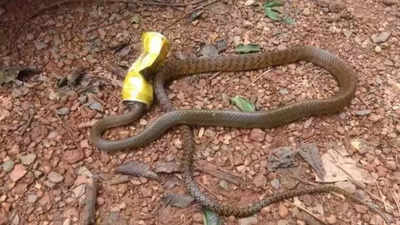Though encountering a snake might make your heart race, not all snakes are to be feared. While avoiding venomous snakes is wise, rat snakes are generally harmless and are known for their gentle nature. These non-venomous constrictors can grow up to eight feet long and are found across the globe.
Here are eight intriguing facts about rat snakes that showcase their unique ecological roles. Rat snakes belong to the Colubridae family, which encompasses two-thirds of the world’s snake species. This family is characterised by legless bodies (contrary to some legged snake species), absence of upper teeth, and fewer head scales.

They possess slender bodies and flat bellies. Specifically, rat snakes are part of the Colubrinae subfamily, which includes both New World and Old World genera. While some Colubrids are venomous, they rarely pose a threat to humans due to their lack of front fangs and their need to chew to inject venom.
Rat snakes, in particular, are non-venomous, with only a few exceptions. They are widespread, except for Antarctica, with the highest diversity found in North America, Asia, North Africa, and the Middle East. Rat snakes are part of the colubrid family, which is the largest snake family.
If you encounter a non-venomous snake and it's not a boa, python, viper, rattlesnake, or elapid (like cobras or mambas), it’s likely a colubrid. Colubrids, including milk snakes, kingsnakes, garter snakes, and rat snakes, are widespread across all continents except Antarctica. While some colubrids can be venomous, rat snakes are harmless.
"New World" rat snakes, found in North America, range from Mexico to Canada and can grow quite large. For example, the eastern rat snake can reach up to 8.4 feet (2.
6 metres). In contrast, the "Old World" rat snake, such as the Oriental rat snake (Ptyas mucosa) from southern Asia, can grow up to 9.8 feet (3 metres).
Genetic studies suggest that while all rat snakes may have common ancestors from tropical Asia, New World rat snakes are more closely related to kingsnakes than to Old World rat snakes. The corn snake (Pantherophis guttatus) is a widely kept pet in the U.S.
, found in areas like New Jersey and Florida. Known for its vibrant colours and docile nature, it's a favourite among beginner reptile keepers. Captive corn snakes come in over 800 colour morphs, with some rare varieties costing up to $1,000.
The king cobra, the longest venomous snake, can reach lengths of 10 to 18 feet (3 to 5.4 metres). It specialises in consuming other snakes, including Old World rat snakes like the dhaman.
To mimic the threat of rattlesnakes, some New World rat snakes, such as the western rat snake, vibrate their tails against dry vegetation to produce a buzzing sound. This mimicry helps deter potential predators. Rhinoceros rat snakes from Asia are notable for the horn-like scales on their snouts.
These protrusions resemble rhino horns but their exact purpose remains unclear. Unlike some colubrids that give birth to live young, rat snakes lay eggs. They typically produce clutches of 9 to 20 eggs, depending on the species.
Rat snakes, including the eastern rat snake, use constriction to subdue their prey. They primarily consume rodents, lizards, amphibians, and occasionally birds. The beauty snake (Elaphe taeniura), native to Asia, is known for its attractive appearance and diet of bats.
This slender snake can grow up to 8 feet (2.4 metres) long and is often kept as a pet. By controlling rodent populations, rat snakes play a valuable role in agriculture.
They help prevent crop damage and reduce the spread of diseases carried by rodents. Owl species and their characteristics: From tiny screech-owls to majestic great horned owls and their unique habitats.



















